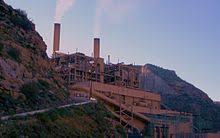Water pollution
Coal-fired boilers, using either coal or lignite rich in limestone, produces fly ash containing calcium oxide (CaO). CaO readily dissolves in water to form slaked lime (Ca(OH)2) which is carried by rainwater to rivers/irrigation water from the ash dump areas. Lime softening process precipitates Ca and Mg ions / removes temporary hardness in the water and also converts sodium bicarbonates in river water into sodium carbonate. Sodium carbonate (washing soda) further reacts with the remaining Ca and Mg in the water to remove / precipitate the total hardness. Also, water-soluble sodium salts present in the ash enhance the sodium content in water further. Thus river water is converted into soft water by eliminating Ca and Mg ions and enhancing Na ions by coal-fired boilers. Soft water application in irrigation (surface or ground water) converts the fertile soils into alkaline sodic soils. River water alkalinity and sodicity due to the accumulation of salts in the remaining water after meeting various transpiration and evaporation losses, become acute when many coal-fired boilers and power stations are installed in a river basin. River water sodicity affects downstream cultivated river basins located in China, India, Egypt, Pakistan, west Asia, Australia, western US, etc.
Pollutant discharges from ash ponds to surface waters typically include arsenic, lead, mercury, selenium, chromium, and cadmium. In the US, discharges to surface waters are regulated by permits in the National Pollutant Discharge Elimination System (NPDES).
Waste management
See also: Health effects of coal ash

Aerial photograph of Kingston Fossil Plant coal fly ash slurry spill site taken the day after the event (23 December 2008)
The burning of coal leaves substantial quantities of fly ash, which is usually stored in ash ponds (wet storage) or landfills (dry storage). Pollutants such as heavy metals leach into groundwater from unlined ponds or landfills, and can pollute aquifers for decades or centuries. The EPA classified 44 sites in the US as potential hazards to communities. Such a classification means that the waste sites could cause death and significant property damage if an event such as a storm, a terrorist attack or a structural failure caused a spill. EPA estimated that about 300 dry landfills and wet storage ponds are used around the country to store ash from coal-fired power plants. The storage facilities hold the noncombustible ingredients of coal, including the ash captured by equipment designed to reduce air pollution.
In the low-coal-content areas waste forms spoil tip.
Wildlife
Surface mining of coal causes direct and indirect damage to wildlife. The impact on wildlife stems primarily from disturbing, removing and redistributing the land surface. Some impacts are short-term and confined to the mine site however others have far-reaching, long-term effects.
The most direct effect on wildlife is destruction or displacement of species in areas of excavation and spoil piling. Pit and spoil areas are not capable of providing food and cover for most species of wildlife. Mobile wildlife species like game animals, birds, and predators leave these areas. More sedentary animals like invertebrates, reptiles, burrowing rodents, and small mammals may be destroyed. The community of microorganisms and nutrient-cycling processes are upset by movement, storage, and redistribution of soil.
Degradation of aquatic habitats is a major impact by surface mining and may be apparent many miles from a mining site. Sediment contamination of surface water is common with surface mining. Sediment yields may increase a thousand times their former level as a result of strip mining.
The effects of sediment on aquatic wildlife vary with the species and the amount of contamination. High sediment levels can kill fish directly, bury spawning beds, reduce light transmission, alter temperature gradients, fill in pools, spread streamflows over wider, shallower areas, and reduce the production of aquatic organisms used as food by other species. These changes destroy the habitat of valued species and may enhance habitat for less-desirable species. Existing conditions are already marginal for some freshwater fish in the United States, and the sedimentation of their habitat may result in their extinction. The heaviest sediment pollution of drainage normally comes within 5 to 25 years after mining. In some areas, unvegetated spoil piles continue to erode even 50 to 65 years after mining.

